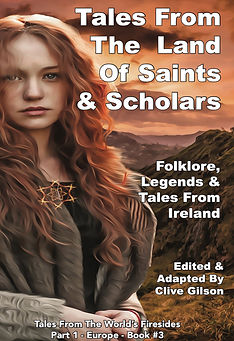Tales From The Land Of Saints And Scholars
Watch:
Fior Usga
Synopsis
This volume, Tales from the Land of Saints and Scholars, is the Irish collection, part of a series covering the whole of the British and Irish islands. These tales are drawn from some of the great collectors of Celtic and Irish storytelling, and as ever, these stories illustrate the beauty and the darkness inherent in our ancestral memories and in our “modern” interpretations of this confusing world.
Reading Irish fairy tales and legends can be a rewarding experience for various reasons:
Irish folklore is deeply rooted in the country's cultural history. Exploring Irish fairy tales provides a glimpse into the traditions, customs, and beliefs of the Irish people throughout the ages.
Irish mythology features a rich pantheon of gods, goddesses, and legendary figures such as the Tuatha Dé Danann, Cú Chulainn, and Fionn mac Cumhaill. Reading these tales allows you to immerse yourself in a unique and vibrant mythological world.
Irish fairy tales often depict magical realms and supernatural beings, including leprechauns, fairies, and banshees. These fantastical elements add a sense of wonder and enchantment to the stories.
The stories often incorporate Celtic symbolism and motifs, providing insight into the ancient Celtic worldview. Symbols like the Celtic knot, triskelion, and shamrock are sometimes woven into the narrative.
Many Irish myths and legends are believed to contain allegories for historical events, making them a fascinating way to explore Ireland's past. The tales often blend history with mythology, offering a unique perspective on the country's heritage.
Like many traditional fairy tales, Irish stories often convey moral lessons and wisdom. Themes of bravery, loyalty, and the consequences of one's actions are common, making the tales both entertaining and instructive.
Irish storytelling is known for its lyrical and poetic qualities. Reading Irish fairy tales allows you to appreciate the artistry of the language and narrative techniques employed by traditional storytellers.
Irish fairy tales contribute to the shaping of Ireland's national identity. They are an integral part of the cultural heritage, fostering a sense of continuity and connection among the Irish people.
At their core, Irish fairy tales are captivating stories filled with adventure, magic, and memorable characters. Whether you're reading them for cultural exploration or pure enjoyment, these tales have a timeless appeal.
In conclusion, delving into Irish fairy tales and legends offers a rich and multifaceted experience. It allows you to connect with Ireland's cultural and mythological roots, appreciate its storytelling traditions, and be enchanted by the magical worlds crafted within these tales.


A Sample...
Bewitched Butter
NOT FAR FROM RATHMULLAN LIVED, LAST spring, a family called Hanlon; and in a farmhouse, some fields distant, people named Dogherty. Both families had good cows, but the Hanlons were fortunate in possessing a Kerry cow that gave more milk and yellower butter than the others.
Grace Dogherty, a young girl, who was more admired than loved in the neighbourhood, took much interest in the Kerry cow, and appeared one night at Mrs. Hanlon's door with the modest request, “Will you let me milk your Moiley cow?"
"An' why would you wish to milk wee Moiley, Grace, dear?" inquired Mrs. Hanlon.
"Oh, just because you're so busy at the present time."
"Thank you kindly, Grace, but I'm no too busy to do my own work. I'll no trouble you to milk."
The girl turned away with a discontented air; but the next evening, and the next, found her at the cow-house door with the same request.
At length Mrs. Hanlon, not knowing well how to persist in her refusal, yielded, and permitted Grace to milk the Kerry cow.
She soon had reason to regret her want of firmness. Moiley gave no more milk to her owner.
When this melancholy state of things lasted for three days, the Hanlons applied to a certain Mark McCarrion, who lived near Binion.
"That cow has been milked by someone with an evil eye," said he. "Will she give you a wee drop, do you think? The full of a pint measure would do."
"Oh, aye, Mark, dear; I'll get that much milk from her, anyway."
"Well, Mrs. Hanlon, lock the door, an' get nine new pins that was never used in clothes, an' put them into a saucepan with the pint o' milk. Set them on the fire, an' let them come to the boil."
The nine pins soon began to simmer in Moiley's milk.
Rapid steps were heard approaching the door, agitated knocks followed, and Grace Dogherty's high-toned voice was raised in eager entreaty.
"Let me in, Mrs. Hanlon!" she cried. "Take off that cruel pot! Take out them pins, for they're pricking holes in my heart, an' I'll never offer to touch milk of yours again."






